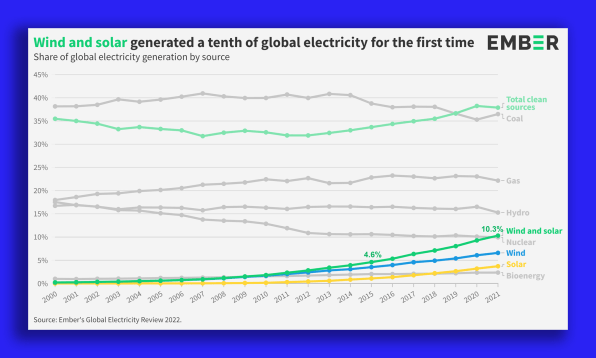Wind and solar hit a record 10% of global electricity generation in 2021
Ramping up renewable energy is crucial to limiting carbon emissions and meeting our climate goals. And in 2021, the world reached a renewable energy milestone: Wind and solar power together accounted for a record one-tenth of global electricity use, reports a new analysis by energy think tank Ember.
According to a report that looked at electricity-generation data for 75 countries, which represent 93% of the global power demand, all forms of nonfossil fuel clean energy—including wind, solar, hydropower, nuclear, and biofuels—accounted for a total of 38% of the world’s electricity generated in 2021. That share was higher than coal, which generated 36% of the world’s electricity.
Such an increase in wind and solar, particularly, marks a stark growth over the last decade. In 2015, when the Paris Agreement was signed, wind and solar generated just 4.6% of global electricity. The share has now more than doubled, to 10.3%. Part of the reason for that growth has stemmed from advancements in technology, which have also helped to cut the costs of wind and solar. Between 2009 and 2019, the price of solar electricity dropped 89%, and the price of onshore wind dropped 70%.

“Across the last decade, we’ve seen an average growth of 20% a year in total wind and solar generation, which is pretty impressive,” says Dave Jones, global electricity analyst for Ember, a U.K.-based think tank focused on finding ways to speed up the transition from coal to clean energy. “But to get ourselves on that pathway for 1.5 degrees [Celsius], we need to see that same 20% through this decade as well.” While we’re at a point where “wind and solar have arrived,” Jones says. The question now is, “‘How do you keep those high rates of growth that mean [wind and solar] keep rising up to become 40% of the electricity mix by 2030?’ Which is what we need to be on that 1.5 degree [Celsius] pathway. There’s so much more work to do.”
There are now 50 countries that have crossed that 10% wind and solar generation mark, and seven countries hit that milestone in 2021: China, Japan, Mongolia, Vietnam, Argentina, Hungary, and El Salvador, according to the report. Three countries in particular have shown a particularly fast transition, with Vietnam, Australia, and the Netherlands having moved 8% of their total electricity demand over to wind and solar from fossil fuels in only the last two years. These countries set a precedent, Jones says, to show other policy makers “there are ways to do this and not worry about keeping the lights on.”
Fossil fuels still account for the majority of energy consumption, generating 62% of the world’s electricity in 2021—up from 61% in 2020. At the end of 2021, emissions experts noted that, with the global economy firing up again after the 2020 lockdowns, global electricity demand jumped, and emissions increased—canceling out any pandemic-related emissions reductions. Coal, in particular, rose, after years of declining, to a new all-time high. The energy crisis spurred by Russia’s invasion of Ukraine has put another spotlight on coal and gas, with both fossil fuels seeing rising prices. That crisis could incentivize countries to expand their wind and solar, Jones says, so that they don’t have to import those fuels and can “have their own home-grown electricity.”
With this 10% milestone for wind and solar reached, Jones emphasizes the need to keep this momentum. “Wind and solar have got to be the backbone of the electricity system,” he says, though he adds that all renewable technologies (like hydro, the growth of which actually fell in 2021) need to be scaled up to fill any energy gaps. Solar and wind technology, along with public acceptance and ambitious commitments, have come a long way. The next step is speeding up implementation, which, Jones notes, “is in the hands of governments as gatekeepers to make sure it actually happens and all that potential comes through.”
Fast Company , Read Full Story
(30)



